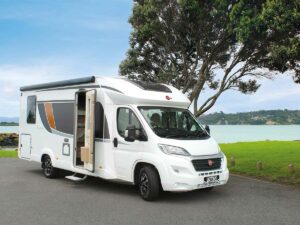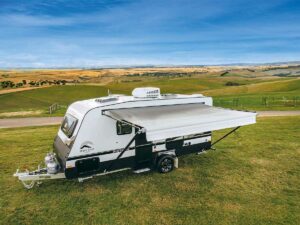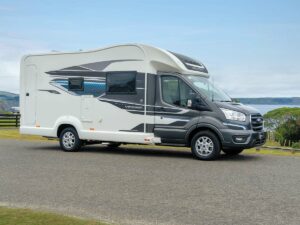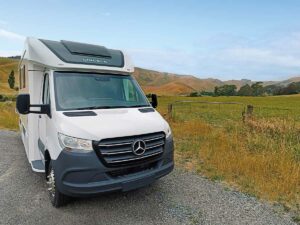Explorer customers like to go places most motorhomes can’t go—where the roads are rutted and rough and the creek crossings are too steep and deep for the average motorhome owner to contemplate crossing.
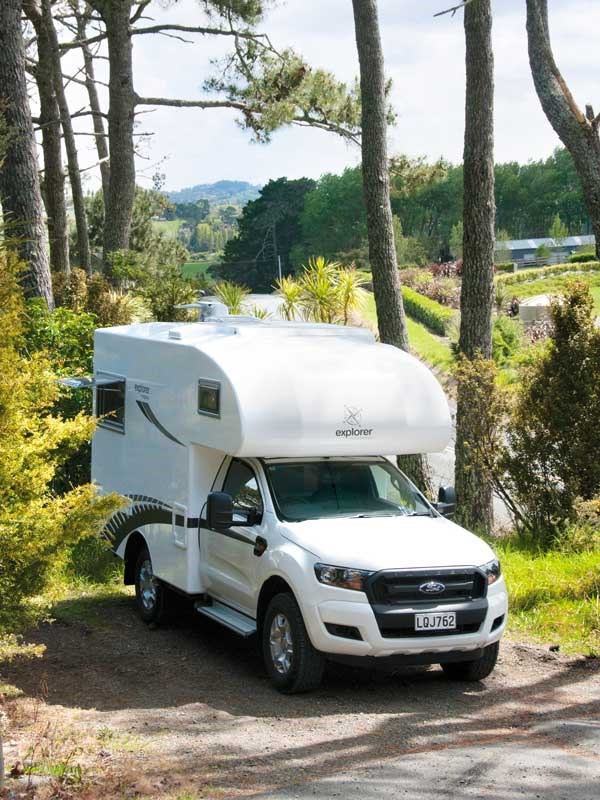 |
Built for rutted roads and steep, deep creek crossings |
The Explorer Compass is one of the success stories of the New Zealand motorhome industry having been in production in Auckland for more than 11 years. It’s one of three models in the Explorer range along with the slightly larger Navigator and the slide-on Backpack.
Dimensionally, there is not much difference between the Compass and the Navigator, the Navigator being 80mm wider, with 150mm more floor length and a 100mm extra depth in the Luton over the cab.
I first reviewed the Compass six years ago (MCD #93, June 2012) and while the body components are still the same, the detail in today’s Compass is more sophisticated.
The secret of its success lies in the steady evolution of the product that keeps it up to date with technological change as well as incorporating customer suggestions for improvement.
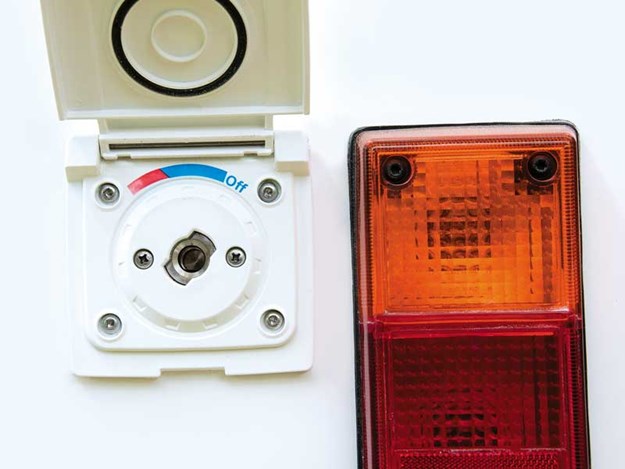 |
Optional external shower point |
An example of this constant improvement is the battery management system employed by Explorer in their motorhomes. When I reviewed the Navigator (MCD #158, Aug 2017), it was one of the first to be fitted with the highly regarded CTEK D250SA regulator linked to a SmartPass 120.
Fifteen months later, this Compass was the first to be fitted with the Redarc ‘Manager30’, a 30-amp state-of-the-art battery management system designed to charge and maintain auxiliary batteries by incorporating AC, DC, and solar inputs.
An ‘all in one box system’, it operates like six separate products, charging an auxiliary battery from the vehicle while on the move, a 240-volt charger, a solar regulator, a battery isolator, a load disconnect controller—all monitored by a remote display.
The Redarc ‘Manager30’ replaced the CTEK product because it was a better fit with the needs of both Explorer and their customers.
Exterior
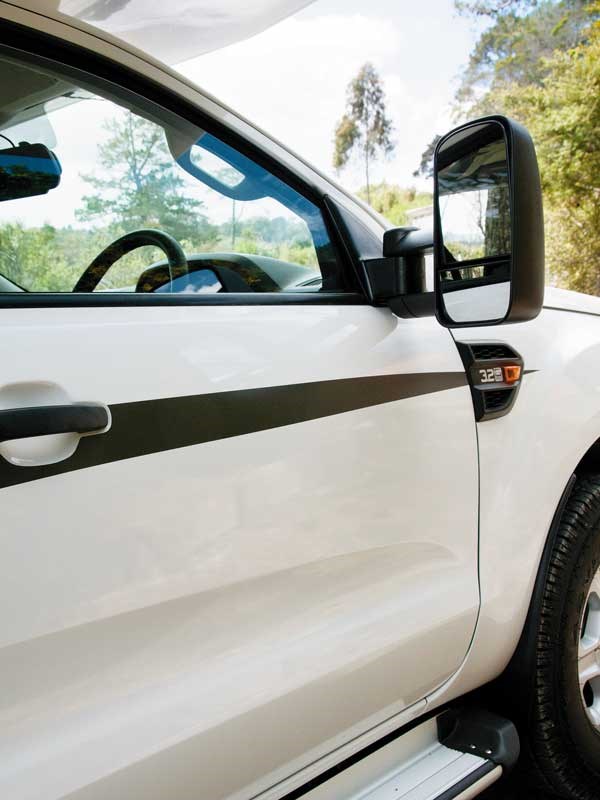 |
Recommended running boards and Clearview extending mirrors |
The Compass standard specification is built on a Ford Ranger two seat single cab with a 3.2-litre five-cylinder turbo-diesel motor, a six-speed automatic gearbox, and four-wheel drive.
Like all good RV manufacturers, Explorers are weight conscious. By constructing their cabinetry using ‘Featherlite’ laminate surfaced plywood and employing the foam sandwich construction technique to build the body, they save weight without sacrificing strength.
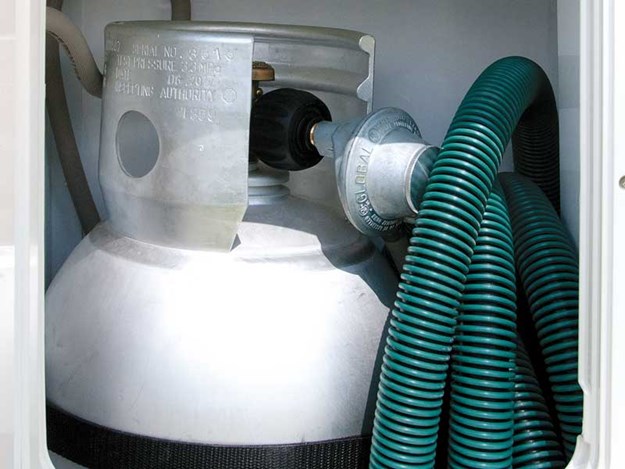 |
Weight-saving alloy 5kg LPG bottle |
The Compass body sits well on the Ranger chassis, harmoniously matching the lines of the cab. A tastefully stylised silver fern adorns each side of the vehicle. Kerbside at the rear corner an LPG locker houses a 5kg alloy bottle with room for a second. Across the back, a large hatch provides access to storage under the rear settee.
The standard Ford rear leaf springs have been uprated by Archers Springs fitting an extra leaf to accommodate slightly more load as well as providing a smoother ride.
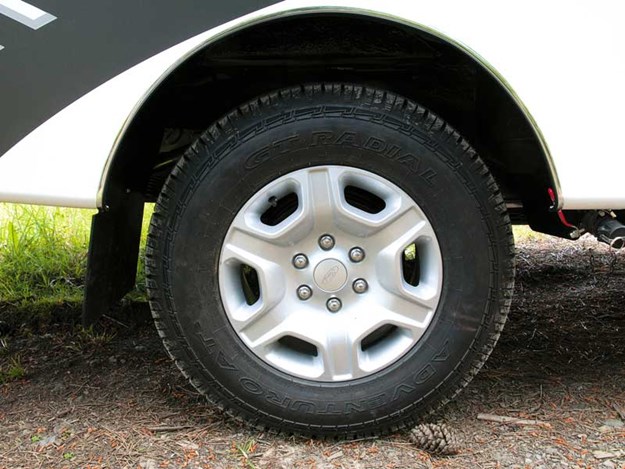 |
Optional alloy wheels fitted with GT Radial tyres |
Other options fitted here are the towbar (a removable tongue model), an outside shower connection point, and a reversing camera—in this case, an RSE dual camera model fitted with a heater to prevent the camera lenses fogging up in cold weather.
Explorer recommends fitting the optional running boards each side as they do a good job protecting the bodywork from stone damage, as well as Clearview extending side mirrors that allow better vision rearwards. The optional alloy wheels are also recommended as they accept GT Radial tyres that are better suited to off-road use.
Interior
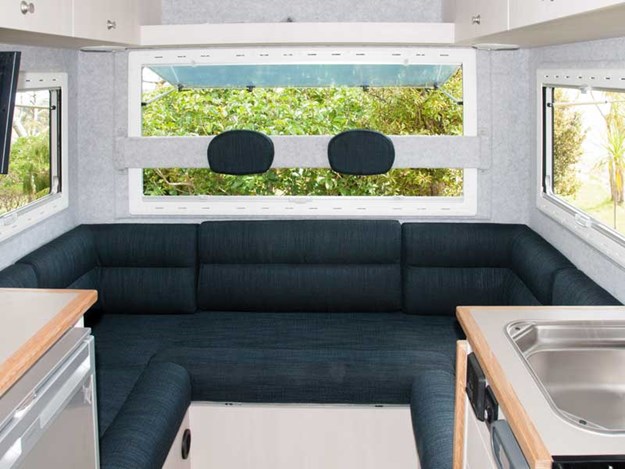 |
Lounge converts to a double bed, and the headrests are removeable |
Entry through the centrally locked Hartal habitation door is made a lot easier by using the single alloy pull-out step provided. A neatly moulded step-well takes your second step, and the third sees you safely aboard. A solid grab handle on the right can help ‘steady the ship’.
First impression of the inside styling is clean, straight lines, minimalist, with just a hint of timber, and attractively upholstered cushions.
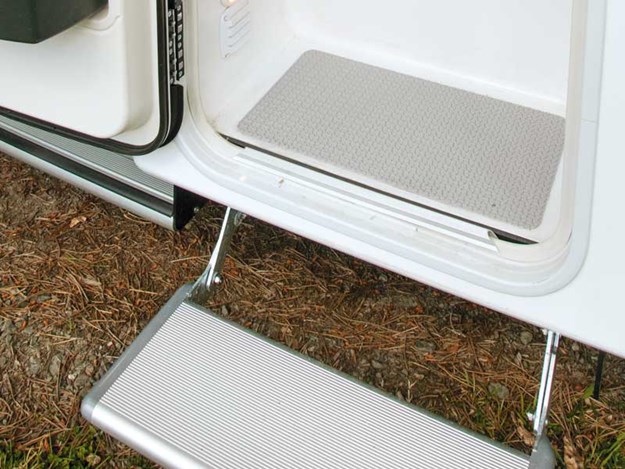 |
Easy access entry |
On entering, to the left in the space above the cab (the Luton) is the main bed, straight ahead the bathroom, and immediately right the kitchen with a U-shaped lounge at the rear.
Bedroom
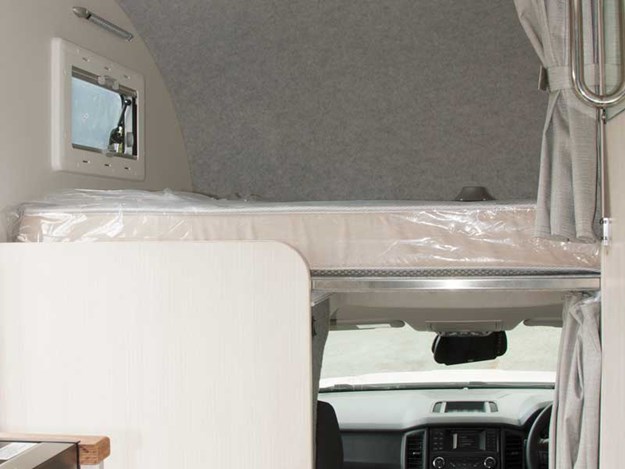 |
Easily accessed Luton bed |
One feature that makes the Compass interior seem so spacious is the easily accessed bed in the Luton. It is lower than most Lutons and with an easy-to-use mounting platform, one step up allows you to sit on the bed—an acceptable arrangement for most buyers.
At 1950mm x 1350mm, it is big enough for all but the very tallest. Fitted with the latest ‘Starfish’ foam mattress, with a breathable base, it offers the prospect of restful nights of sleep. With an LED reading light and a small opening window each end of the bed, there is a choice as to which way around you sleep. The 850mm headroom provides adequate room to sit up in bed and a pair of curtains provides privacy when needed.
With gas strut assistance, the Luton bed lifts out of the way making it easier to gain access to the cab. Until you perfect your technique it is a bit of a scramble, but it is still the better option on a rainy day.
Bathroom
There is no disguising the fact that the bathroom is compact; just the width of a Thetford C400 series toilet (around 670mm) and 900mm long. It has an easy clean moulded acrylic lining and a moulded corner basin unit with a single lever faucet.
The shower has a flexible hose with its handpiece mounted on a wall rail. An optional mirror-doored wall cabinet provides storage for toiletries. Another useful optional extra is the wall-mounted concertina drying rail. All lights are LED and there is a vent in the ceiling. Everything you need but not a place to linger.
Kitchen
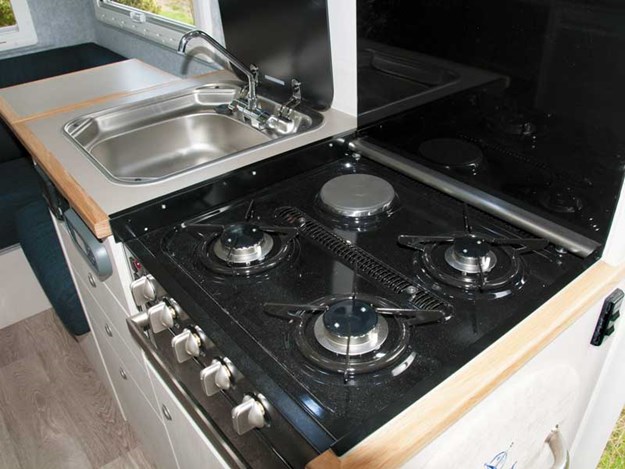 |
The long benchtop provides good workspace |
If the bathroom is compact then, to be fair, the kitchen is a winner spacewise and would put many ‘Euro-kitchens’ to shame. A grill-oven is fitted rather than a full oven and the cooktop has three LPG hobs plus a single electric hob.
Overhead is the latest Camec ducted rangehood. Alongside is a generous sized stainless steel sink with a faucet that folds away to allow the glass sink cover to fold flat. At the end of the bench is a folding extension.
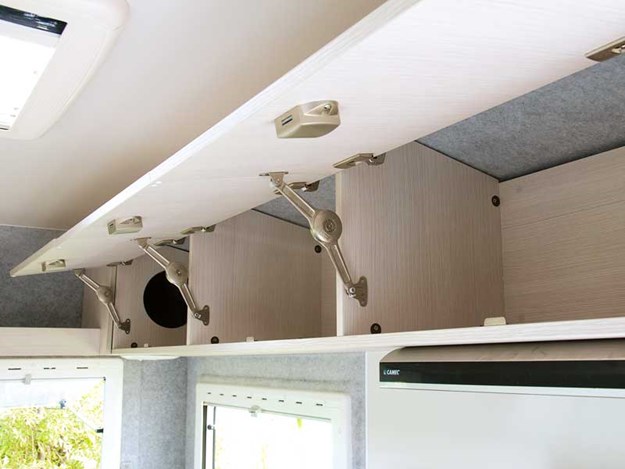 |
Ample overhead storage |
With the hobs and sink lids lowered and the bench extension raised, the worktop is around 1500mm long. There is excellent storage in the drawers and cupboards below the bench plus the five overhead lockers.
Opposite the kitchen bench is the two-way Waeco 136-litre fridge with separate freezer compartment (12V/240V). Explorer moved away from three-way fridges some time ago, saving weight and extending the life of the LPG bottle not having to run a gas fridge. Fitting 300 watts of solar panels and a genuine 150a/h AGM house battery ensures a steady flow of DC power to keep the fridge alive.
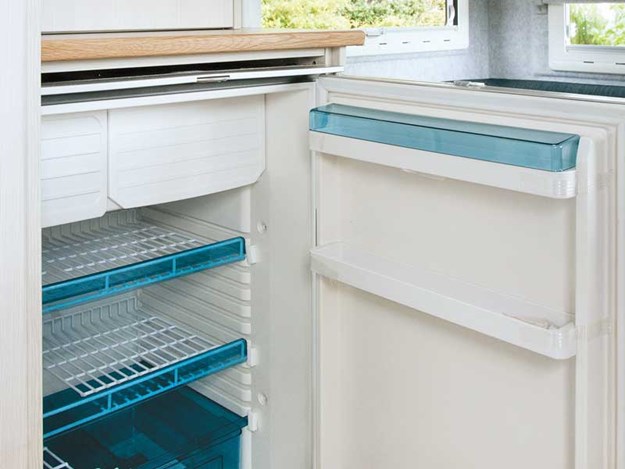 |
Waeco 12V compressor 136L fridge |
Lounge
Bringing up the rear is a U-shaped lounge—a place for relaxing, dining, entertaining and, when needed, sleeping. Yes, pulling out the slat base converts it into a narrow double bed (1950x1150mm). The cushions are shaped for comfort so it is a good place to relax at the end of an active day’s adventures.
Conspicuous by its absence, the freestanding dining table can be used both inside and outside and stores away when not needed. A radio/auxiliary player head with stereo speakers is standard. These speakers mounted above the settees also house LEDs that serve as reading lights.
TV is optional. This one had an RSE 19-inch TV and an NZSat auto satellite aerial fitted. To keep warm, the buyers opted for the optional Eberspacher 2kW diesel heater. Two headrests are mounted on an upholstered bar above the rear seats. These seats are belted for two passengers. If there are no passengers aboard, the headrest bar can be removed.
On the road
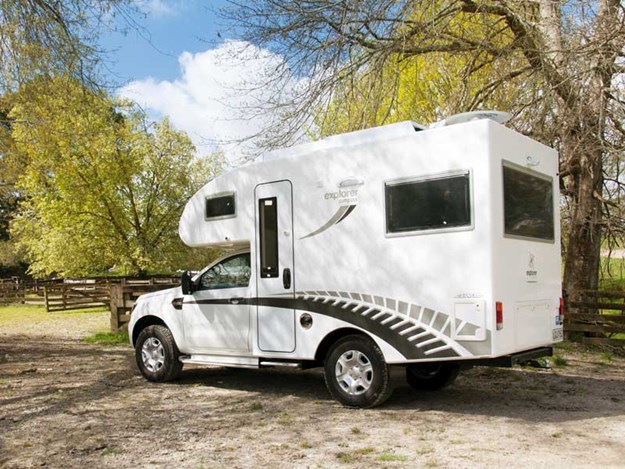 |
Featherlite ply cabinetry and foam sandwich GRP construction keep the weight down |
All Explorer motorhomes are sold fully compliant with a Certificate of Compliance (LPG), an Electrical Warrant of Fitness, Certified Self Contained (CSC), and a Warrant of Fitness.
While you can hit the road with all the basics needed to ‘go bush’, there is a suite of additional items you can choose to personalise your Compass with features that are important to you. Explorer claims all Compass models built so far have been different.
This ‘personalisation’ of their motorhomes is an important factor in Explorer’s success story. Prices start at $138,000 for the base model built on Ranger cab/chassis with a five-cylinder motor through a six-speed auto transmission and part-time 4WD with high/low ratio.
Explorer Compass specifications
| Vehicle make/model | Explorer Compass |
| Engine | 5-cylinder 3.2L turbo diesel |
| Transmission | 6-speed auto |
| Berths | 4 |
| Approx. overall length | 5650mm |
| Approx. overall height | 3000mm plus sat. dish |
| Tanks | 95L fresh |
| Gas | 1 x 5kg |
| GVM | 3200kg |
Explorer Compass price (as reviewed): $138,000
Additional specifications
- Airbags: Driver, passenger, front, and curtain
- ABS brakes with dynamic stability control
- Safety Rating: 5-Star Euro NCAP and ANCAP
- Cruise control, Bluetooth, remote central locking, engine immobiliser, power windows and mirrors, cab air conditioning.
Pluses
- Go anywhere motorhome
- A Luton bed that works
- Great range of options
Minuses
- Very compact bathroom
For more information on the Explorer Compass, visit explorermotorhomes.co.nz or call Simon and Mike on 0800 227 144.

